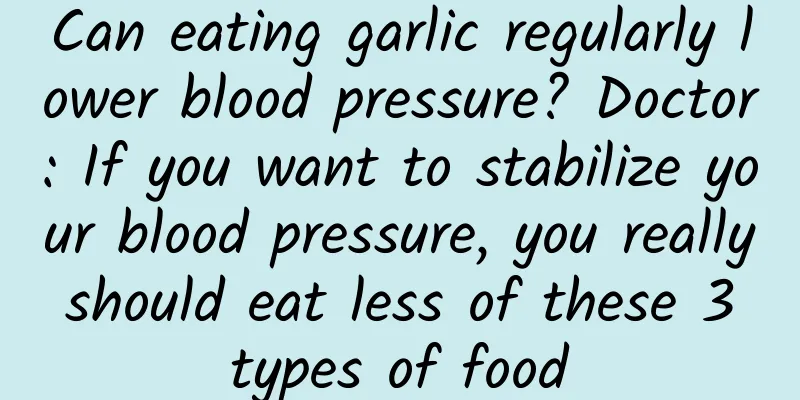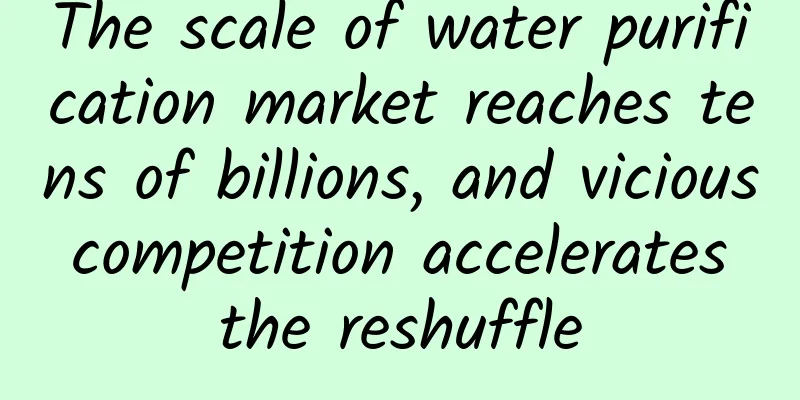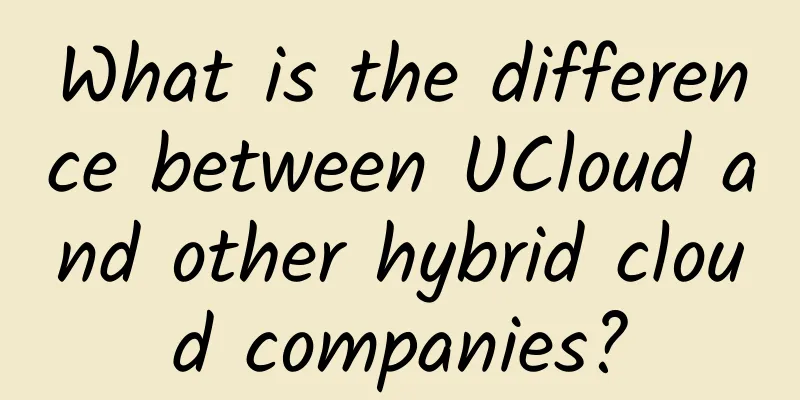Can eating garlic regularly lower blood pressure? Doctor: If you want to stabilize your blood pressure, you really should eat less of these 3 types of food

|
Reviewer of this article: Chen Haixu, Deputy Director and Master Supervisor of the Second Medical Center of PLA General Hospital Garlic is a common food in daily life and is often used as an ingredient. It has anti-inflammatory, bactericidal and antioxidant benefits, and can also help improve immune function. However, some people believe that allicin in garlic can lower blood pressure and prevent cardiovascular disease; others believe that garlic is irritating and not suitable for people with high blood pressure, as it may cause accidents! So which statement is correct? Does garlic raise or lower blood pressure? Garlic is actually good for blood vessels. Studies have found that allicin in garlic is a natural antioxidant that can effectively reduce the probability of low-density lipoprotein (LDL) carrying cholesterol into the arteries, thereby preventing atherosclerosis, myocardial ischemia, angina pectoris, etc. Moreover, the hydrogen sulfide produced by the human body after decomposing allicin can relax the smooth muscles around the blood vessels, making the blood vessels more elastic, thereby dilating the blood vessels and lowering blood pressure, thereby reducing the probability of high blood pressure and its complications. From this we can see that eating garlic in moderation is beneficial to high blood pressure and blood vessels, but if you eat too much, it may cause damage to the gastric mucosa. However, it should be noted that not raising blood pressure does not mean that it can be lowered. Allicin ≠ Garlic A certain dose of allicin can indeed prevent cardiovascular disease. But allicin is not the same as garlic. The amount of allicin in garlic used for cooking every day is very small, which is not comparable to the dose of allicin used in the study, and therefore has no clear blood pressure lowering effect. Moreover, allicin itself is an unstable substance. Once it enters the body, it will quickly degrade into other compounds, making it difficult to exert a direct effect. Garlic is just food and cannot replace medicine. Don't think that eating more can produce special effects. Eating too much is bad for your health. Copyright image, no permission to reprint The real culprit behind the increase in blood pressure Since garlic does not increase blood pressure, what is the real culprit? High sodium foods Excessive sodium intake is one of the main causes of hypertension in my country. High sodium intake can cause water and sodium retention, leading to increased blood volume and peripheral vascular resistance, thus increasing blood pressure. In addition to table salt, the pickled vegetables, meat products, snacks, soy products, vegetables and other foods we eat also contain a certain amount of "sodium", especially sauces such as soybean paste and salad dressing, so it is easy to exceed the standard. It is recommended that healthy people should not consume more than 5 grams of salt per day. When buying food, you should learn to read the food ingredient list and choose those with low sodium content. Free sugars Free sugars are also called added sugars, including white sugar, brown sugar, rock sugar, and fructose syrup added during food manufacturing, as well as sugars naturally present in honey and fruit juice. They are all invisible killers that raise blood pressure. High sugar can directly damage vascular endothelial cells and their functions. In order to lower blood sugar, the body releases excessive insulin, which will simultaneously damage blood vessels and stimulate vasoconstriction, thereby stimulating an increase in blood pressure. High-fat foods A high-fat diet will increase blood lipids, increase the risk of arteriosclerosis and plaques, and weaken the elasticity of the arterial wall, which will slowly increase blood pressure. Therefore, eating high-fat foods frequently is not conducive to blood pressure control. Calcium deficiency Reduced calcium absorption will lead to calcium ion channel blockage, and extracellular calcium ions cannot enter cells, thus causing blood pressure to rise. At the same time, calcium ions can also resist sodium ions. If calcium is deficient, sodium excretion will be reduced. Sodium ion retention in the body will cause increased capacity load, leading to increased blood pressure. In addition, calcium is usually inside cells, playing the role of relaxing vascular smooth muscles. In the case of calcium deficiency, the calcium inside cells will enter the blood circulation, making it impossible for smooth muscles to relax, and blood pressure will further increase. Therefore, people should pay attention to calcium intake in their lives, especially pregnant women and older people with osteoporosis, who have a greater demand for calcium. Simple and easy-to-learn "blood pressure reduction method" According to the epidemiological survey data in my country, the incidence of hypertension in my country is 27.9%, which means that one in every three to four people has hypertension. Hypertension can cause blood vessel damage to the main organs of the body, such as the heart, brain, and kidneys, and sudden events can cause great damage. Therefore, it is very important to control blood pressure! Towel-holding method to reduce blood pressure This method was proposed by Canadian doctors and is used by the American Heart Association as an auxiliary treatment for improving blood pressure. According to the standard, you should use a hand gripper, hold your hand at 30% of your maximum grip for 2 minutes, then rest for 1 minute, and repeat 2 times for each hand. But if you don’t have a hand gripper at home, it is recommended to use a towel to achieve the same effect. Specific steps: Fold a towel in half into a square, roll it up from one side, and make it so thick that your thumb does not touch the other four fingers when you hold it in one hand. Use 30% of your strength to hold it for 2 minutes, then rest for 1 minute. Repeat 2 times with each hand, and do it more than 3 times a week. The principle is that when you hold the towel tightly, the arm muscles exert force, compressing the blood vessels, slowing down the blood flow and reducing the volume; after relaxing, the blood vessels release nitric oxide, which can dilate, unclog the blood vessels and maintain their elasticity. This method is safe, simple and will not put any burden on the body. Proper potassium supplementation Studies in many countries have confirmed that eating foods with high potassium content can help lower blood pressure and reduce the risk of stroke in patients with hypertension. The "Dietary Reference Intakes for Chinese Residents" recommends that adults consume 3.6 grams of potassium per day to prevent non-communicable chronic diseases such as hypertension. However, a survey in my country found that in 2012, the daily potassium intake of urban and rural residents was only 1.6 grams per person, less than half of the recommended amount. Therefore, it is recommended to eat more high-potassium foods such as bananas, potatoes, sweet potatoes, beans, and spinach. However, special groups such as kidney patients need to eat less high-potassium foods. Source: I am a great doctor official account The watermarked images and cover images in this article are from the copyright gallery, and the image content is not authorized for reprinting |
>>: Please note when you see this: Don’t cross your legs!
Recommend
How is the spiciness of those notoriously spicy peppers measured?
© National Institute of Standards and Technology ...
This bouncing ball of meat is actually a "sea treasure"?
Review expert: Chen Yu, paleontological restorati...
What happened on the day the dinosaurs went extinct? Silicate dust may tell you
Science Times reporter Wu Tong A climate research...
A brief analysis of precise audience targeting in Internet advertising!
With the development of Internet advertising tech...
The latest APP listing guide for each app store!
The current domestic traffic is becoming increasi...
Six major issues that SEO grassroots webmasters must understand and pay attention to!
Many SEO grassroots webmasters know how to build ...
If Tyrannosaurus Rex traveled to the modern era, would it still be the king of beasts? It might be difficult for it to survive.
There are probably few boys who don't like di...
How Apple is lowering the bar for medical research through software development
[[132519]] One of the biggest difficulties in med...
What is the specific situation of the WTO suspension of the meeting? How long will the suspension last? Attached is the reason for suspension!
On March 10, local time, WTO Director-General Aze...
Domain Downloader v1.0.1 Magnet and other multi-function downloaders_Resource Headlines, Resource Cat
Software Information Name: Domain Downloader Pack...
The latest Douyin operation strategy in 2020
2019 is the best year for TikTok. In terms of the...
B station’s precise traffic diversion strategy!
The sharing value of this article is huge, and it...
Yunnan will start school on March 23 at different times, and Hangzhou will complete the preparation plan for the start of school before March 25
As provinces gradually clarify the start time of ...
How to make a wedding app? How much does it cost to customize and develop a wedding app?
In recent years, the wedding market has shown a m...
3 laws of hit products!
In the post-mobile Internet era with the implemen...

![Ningxia College Entrance Examination Score Line 2020 [First and Second Score Line Released] 2020 Ningxia College Entrance Examination Score Line List](/upload/images/67cc3b9cd447d.webp)







